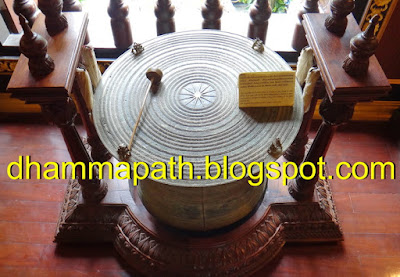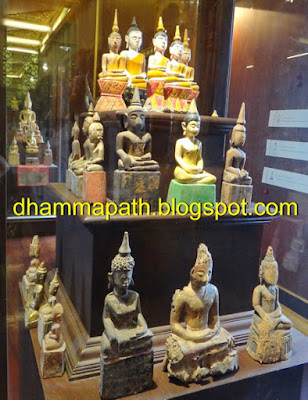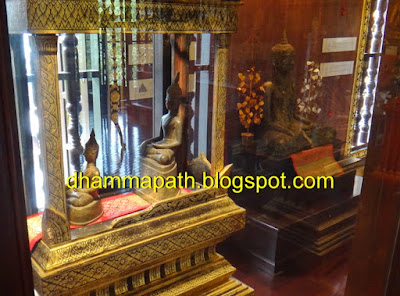If you are in ChiangRai, dont miss visiting SaengKaew Museum at Wat Phra Kaew - ChiangRai. This sacred SaengKaew Musuem was built in 1995 in the contemporary northern style, the museum contains numerous interesting objects, especially of the typical northern culture Religious Art of Lanna history. Preserved here also are the belongings of two respected late monks: Phra Buddhiwongwiwat and Somdet Phra Buddha Chinawong. The former was late abbot of the temple and the Provincial monks’ Governor of Chiang Rai and the latter was the abbot of Wat Benjamabopitr, Bangkok and the monks’ Governor of the whole northern Thailand. Both of them had made a lot of contributions to the development of Buddhism in ChiangRai.
The Northern style of the SaengKaew Museum is house of storage Lanna Religious Art. Here the main entrance and entry is free of charge. It operates seven days a week from 9.00 to 17.00 o’clock.The photo taken at main altar of Saeng Kaew Museum, the sacred Phra Buddha Sri ChiangRai, the style of Buddha Chiang Saen, this bronze image, covered with gold leaf, is seated in the position of Calling the Earth to Witness. Designed by Acharn Saner Nindej, it was commissioned in 2001 as the presiding Buddha image in the Hong Luang SaengKaew, the museum of Wat Phra Kaew. At back side is Tung Kradang. The sacred Tung Kradang in this museum depict the history of the Emerald Buddha, according to Lanna chronicles and include the creation of the Jade Buddha of Chiang to commemorate the history of the temple.
The shell of "Green Turtle", "LongHead Red Turtle" and "Asian Forest Tortoise".
The sacred variety stone statues of Phra Buddha.
The close look for the Phra Buddha Sri ChiangRai, the style of Buddha Chiang Saen.
The sacred Prasat Abode. The Prasat is where the Buddha statue image, heavenly beings or royalty may be enthroned. The roof is the representation of Mount Sineru at the center of the universe.
The old GongGob. This magnificent bronze drum is known as frog drum or rain drum. It is now believed by most independent scholars to have originated in northern Vietnam, Dong Son Culture, in the fifth century BC.The original drums were used in ritual ceremonies.
The PhraThat of Relic, a reliquary designed to contain and exhibit the remains and relics of saints. This is a philatory, a transparent reliquary.
The huge collection of Old Lanna Phra Buddha statues.
The metal bronze of Lanna Phra Buddha statue.
The sacred Phra Chao Tan Jai. The people of Lanna believe that Phra Chao Tan Jai will facilitate a person’s wishes in a timely manner.
Many more Old Lanna Phra Buddha statues included, Phra U-Thong, Phra Buddha Sukhothai, Phra Buddha ChiangSean and others.
The sacred Phra Bua Khem, one manifestation of Phra Upakut, representing one of the Lord Buddha’s disciples in meditation on the ocean floor. The base is usually decorated with shells, crab and fish and the head is covered with lotus leaves. There are 9 small raised points on the body: one on the forehead, two on the shoulders, two on the knees, two on the hip and two on either the wrist or the elbow, representing the original remains of the Lord Buddha and his disciples which were enshrined in holy reliquaries. The name Bua Khem, meaning “head of the pin”, refers to these small raised points. Burmese believe that veneration of this image will help to guide them on the right path and bring luck and prosperity.
The sacred collection of old antique Phra Buddha statue.The Phra Chao Ha Phra-Ong, the sacred seed.
The antique Alm Bowl, Roller-ing and other stuff.
The old Mantra book.
The altar with antique Phra Buddha statues.
The Heed Tham. Religious texts and books are preserved in wooden chests. Often carved and lacquered, they were used to store the libraries in the temples of Lanna.
The sacred Phra Buddha Ratnakorn Navuti Wassanusornmongkhol.
.
See amulets from Wat Phra Kaew - ChiangRai at:
http://thaiamulets-dhammapath.blogspot.my/search/label/Wat%20Phra%20Kaew%20%28ChiangRai%29
.
See more Thai amulets at:
http://www.thaiamulets-dhammapath.blogspot.com/






















































